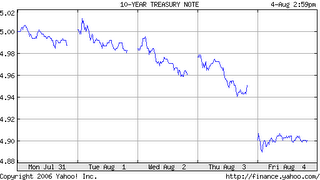
The major debate regarding the economy centers on the real estate/housing picture. Last week a headline in the Financial Times read, "Housing Data Not as Gloomy as Bears Think." The article went on to say that house inflation in both the UK and Australia declined to zero, yet nothing bad resulted. Price inflation held low in both places for three or four quarters, and then inflation started up again. In both the UK and Australia central banks have since raised their rates. No disasters there.
The latest issue of Business Week adheres to the same optimism, with an article that's headlined, "Housing: The Roof Won't Collapse on the Economy. As builders adjust their inventories, other sectors will offer plenty of support."
But wait -- the most intelligent piece I've read regarding housing comes from that brilliant economist, Paul Kasriel, of Northern Trust. He notes that the figures for July show that new family homes sold were down 22.2% from July a year ago. At the same time, New family homes for sale in July were up 22.4% from a year ago.
The spread between the two was 44.6%. By this measure, states Kasriel, the supply/demand situation for new single-family homes was the worst since July 1972.
Kasriel notes that falling prices for new single-family homes will put pressure on existing home prices, and therefore we can look forward to a decline in residential home construction. Downward pressure on existing home prices will lead to increased mortgage defaults as home-owners may find that the new payments on their variable-rate mortgages amount to more than the declining value of their homes.
Thus the greatest housing bubble in US history appears to be fizzling. I don't know whether this is going to be a slow, tortuous process or more of a shorter-term bursting of the bubble.
The latest Economist magazine includes an article entitled, "What's That Hissing Sound?" A paragraph from the article runs as follows; "The boom has lifted the (US) economy in three ways: it has boosted residential construction: it has made people feel wealthier and so encouraged them to spend more; and it has allowed homes-owners to use their property as a gigantic cash machine, taking out money by borrowing against their capital gains. Merrill Lynch estimates that the three together accounted for more than half of America's total GDP growth since last year. "Counting construction, finance, and estate agency, the housing boom has been responsible for one-third of all the jobs created since 2001. If house-price rises level off, GDP growth could dip below 2% in 2007. If prices fall, expect a steeper slowdown."
Finally, yesterday's New York Times carried major article which starts by noting the numerous "for sale" signs now dotting the landscape. The article continues, "Already, the housing slowdown has begun damaging the job market. Builders, mortgage lenders, and real estate agencies have stopped adding to payrolls. . . Perhaps the biggest reason to be skeptical about a real estate crash is that the country has not really suffered through one before. Not since the Great Depression has the combined value of residential real estate fallen over the course of a full year."
The Times article includes a fascinating chart, "A History of Home Values," which was researched and assembled by Yale economist Robert Shiller. The Housing Index starts in 1890 at an index value of 125, plunges to 67 in 1920, then rises to 80 in 1940. Back to 70 in 1942, and then a climb to 110 in 1948. From there the Index rises to 115 during the 1960s. In 1980 the Index moves up to 122, and then to 123 in 1990. There's a drop to 110 during the later-1990s, but starting in 1997 the Index rockets higher. After careening ever-higher, we find the Index today at a rarefied price of 200.
The surge from 110 in 1997 to 200 in 2006 is unlike anything seen before on this chart going back to 1890. Anybody studying the chart must conclude that since 1997 we have been experiencing an unprecedented housing bubble.
My own "take" on the whole picture is that home prices and condo prices are heading lower, possibly in an extended, tortuous decline. And God help us if home prices regress to the mean. If that happens, prices could easily lose 40% to 50% on balance.
The major home builders have taken a huge beating. TOL has declined 61%, which is typical for the home-builders. The stock is now oversold, and probably ready to rally with the rest of the home-builders. Optimists who are predicting a soft landing in real estate will probably applaud a rally in home building stocks as a "sign of a change." But the rally will simply be a "dead cat bounce" from a severely oversold condition.























